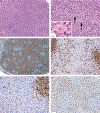Nodular lymphocyte-predominant hodgkin lymphoma with atypical T cells: a morphologic variant mimicking peripheral T-cell lymphoma
- PMID: 21997687
- PMCID: PMC6324169
- DOI: 10.1097/PAS.0b013e31822832de
Nodular lymphocyte-predominant hodgkin lymphoma with atypical T cells: a morphologic variant mimicking peripheral T-cell lymphoma
Abstract
Nodular lymphocyte-predominant Hodgkin lymphoma (NLPHL) is a distinct Hodgkin lymphoma subtype composed of few neoplastic lymphocyte-predominant (LP) cells in a background of reactive small B and T cells. We have seen occasional NLPHL cases that contain background T cells with prominent cytologic atypia, raising the differential diagnosis of peripheral T-cell lymphoma not otherwise specified (PTCL-NOS) or a composite lymphoma. We sought to characterize the clinicopathologic features of such cases. Eleven NLPHL cases with atypical T cells diagnosed from 1977 to 2010 were identified at 2 institutions and compared with 24 control NLPHL cases lacking atypical T cells. All 9 male patients and 2 female patients presented with localized peripheral lymphadenopathy. In comparison with control patients, they were younger (median age, 13.8 vs. 36.1 y; P=0.015), with more frequent cervical lymph node involvement (54.5% vs. 8.3%, P=0.015). In all 11 cases, areas of NLPHL with typical B-cell-rich nodules containing LP cells were present. Nine cases contained sheets of atypical T cells surrounding primary and secondary follicles in a pattern mimicking the T-zone pattern of PTCL-NOS; the remaining 2 cases contained atypical T cells presented as large clusters at the periphery of B-cell-rich nodules. In all cases, the atypical T-cell-rich areas contained rare scattered LP cells, which were IgD in 5 of 7 cases (71.4%). The atypical T cells showed no pan-T-cell antigen loss or aberrant T-cell antigen expression in any case, and polymerase chain reaction or Southern blot analysis showed no evidence of T-cell clonality in 6 cases tested. The atypical T cells exhibited a variable immunophenotype with respect to germinal center, follicular T-helper, T-regulatory, and cytotoxic T-cell markers. Among 8 patients with clinical follow-up (median follow-up: 6.4 y), 5 patients had recurrent NLPHL at 6 months to 12 years after diagnosis and 6 patients are alive without disease at 9 months to 18 years after diagnosis. In comparison with control patients, NLPHL patients with atypical T cells were more likely to develop recurrent NLPHL (71.4% vs. 13.6%, P=0.008) and to have a shorter time to relapse (P=0.04). Our findings suggest that some cases of NLPHL, occurring predominantly in younger patients, contain prominent populations of morphologically atypical T cells that may raise the possibility of concurrent nodal involvement by PTCL-NOS, a rare diagnosis in children. The clinical behavior of these cases appears similar to that of NLPHL with T-cell-rich diffuse areas, with a higher risk of disease recurrence and no difference in overall survival; however, this finding warrants confirmation in studies of larger numbers of patients.
Conflict of interest statement
Conflicts of Interest and Source of Funding: The authors have disclosed that they have no significant relationships with, or financial interest in, any commercial companies pertaining to this article.
Figures




Similar articles
-
[Nodular lymphocyte-predominant Hodgkin's lymphoma and differential diagnoses].Pathologe. 2013 May;34(3):233-43. doi: 10.1007/s00292-013-1747-4. Pathologe. 2013. PMID: 23494280 Review. German.
-
[Differential diagnosis between nodular lymphocyte-predominant Hodgkin lymphoma and T-cell/histiocyte-rich B-cell lymphoma].Zhonghua Zhong Liu Za Zhi. 2006 Aug;28(8):594-8. Zhonghua Zhong Liu Za Zhi. 2006. PMID: 17243292 Chinese.
-
EBV may be expressed in the LP cells of nodular lymphocyte-predominant Hodgkin lymphoma (NLPHL) in both children and adults.Am J Surg Pathol. 2014 Mar;38(3):316-24. doi: 10.1097/PAS.0000000000000107. Am J Surg Pathol. 2014. PMID: 24525501 Free PMC article.
-
Nodular lymphocyte-predominant Hodgkin lymphoma with nodules resembling T-cell/histiocyte-rich B-cell lymphoma: differential diagnosis between nodular lymphocyte-predominant Hodgkin lymphoma and T-cell/histiocyte-rich B-cell lymphoma.Blood. 2003 Nov 15;102(10):3753-8. doi: 10.1182/blood-2003-02-0626. Epub 2003 Jul 24. Blood. 2003. PMID: 12881319
-
Immunoarchitectural patterns in nodular lymphocyte predominant Hodgkin lymphoma: pathologic and clinical implications.Expert Rev Hematol. 2015 Apr;8(2):217-23. doi: 10.1586/17474086.2015.991388. Epub 2014 Dec 9. Expert Rev Hematol. 2015. PMID: 25487651 Review.
Cited by
-
Critical Role of Flow Cytometric Immunophenotyping in the Diagnosis, Subtyping, and Staging of T-Cell/NK-Cell Non-Hodgkin's Lymphoma in Real-World Practice: A Study of 232 Cases From a Tertiary Cancer Center in India.Front Oncol. 2022 Mar 1;12:779230. doi: 10.3389/fonc.2022.779230. eCollection 2022. Front Oncol. 2022. PMID: 35299754 Free PMC article.
-
Nodular lymphocyte predominance Hodgkin lymphoma of the parotid gland: a case report.Autops Case Rep. 2012 Mar 30;2(1):43-47. doi: 10.4322/acr.2012.007. eCollection 2012 Jan-Mar. Autops Case Rep. 2012. PMID: 31528561 Free PMC article.
-
Overlap between EBV-positive diffuse large B-cell lymphoma, NOS, in a young patient and angioimmunoblastic T-cell lymphoma: A diagnostic pitfall.Clin Case Rep. 2021 Jan 13;9(3):1371-1375. doi: 10.1002/ccr3.3778. eCollection 2021 Mar. Clin Case Rep. 2021. PMID: 33768847 Free PMC article.
-
Automatic lymphoma classification with sentence subgraph mining from pathology reports.J Am Med Inform Assoc. 2014 Sep-Oct;21(5):824-32. doi: 10.1136/amiajnl-2013-002443. Epub 2014 Jan 15. J Am Med Inform Assoc. 2014. PMID: 24431333 Free PMC article.
-
[Nodular lymphocyte-predominant Hodgkin's lymphoma and differential diagnoses].Pathologe. 2013 May;34(3):233-43. doi: 10.1007/s00292-013-1747-4. Pathologe. 2013. PMID: 23494280 Review. German.
References
-
- Alvaro T, Lejeune M, Salvado MT, et al. Outcome in Hodgkin’s lymphoma can be predicted from the presence of accompanying cytotoxic and regulatory T cells. Clin Cancer Res 2005;11: 1467–1473. - PubMed
-
- Atayar C, Poppema S, Visser L, et al. Cytokine gene expression profile distinguishes CD4+/CD57+ T cells of the nodular lymphocyte predominance type of Hodgkin’s lymphoma from their tonsillar counterparts. J Pathol 2006;208:423–430. - PubMed
-
- Bakshi N, Aljabry M, Akhter S, et al. Tumor microenvironment in nodular lymphocyte predominant Hodgkin lymphoma (NLPHL) influences occurrence of relapses and progression to large cell lymphoma (abstract). Blood 2010;116:2684. - PubMed
-
- Bennett MH, MacLennan KA, Vaughan Hudson G, et al. Non-Hodgkin’s lymphoma arising in patients treated for Hodgkin’s disease in the BNLI: a 20-year experience. British National Lymphoma Investigation. Ann Oncol 1991;2(Suppl 2):83–92. - PubMed
Publication types
MeSH terms
Substances
Grants and funding
LinkOut - more resources
Full Text Sources
Medical

